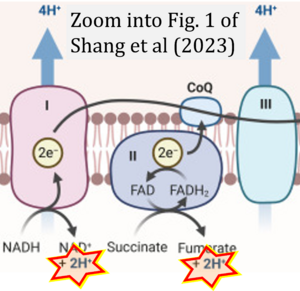Shang 2023 Oncotarget
| Shang E, Nguyen TTT, Westhoff MA, Karpel-Massler G, Siegelin MD (2023) Targeting cellular respiration as a therapeutic strategy in glioblastoma. Oncotarget 14:419-25. https://doi.org/10.18632/oncotarget.28424 |
Shang E, Nguyen TTT, Westhoff MA, Karpel-Massler G, Siegelin MD (2023) Oncotarget
Abstract: While glycolysis is abundant in malignancies, mitochondrial metabolism is significant as well. Mitochondria harbor the enzymes relevant for cellular respiration, which is a critical pathway for both regeneration of reduction equivalents and energy production in the form of ATP. The oxidation of NADH2 and FADH2 are fundamental since NAD and FAD are the key components of the TCA-cycle that is critical to entertain biosynthesis in cancer cells. The TCA-cycle itself is predominantly fueled through carbons from glucose, glutamine, fatty acids and lactate. Targeting mitochondrial energy metabolism appears feasible through several drug compounds that activate the CLPP protein or interfere with NADH-dehydrogenase, pyruvate-dehydrogenase, enzymes of the TCA-cycle and mitochondrial matrix chaperones. While these compounds have demonstrated anti-cancer effects in vivo, recent research suggests which patients most likely benefit from such treatments. Here, we provide a brief overview of the status quo of targeting mitochondrial energy metabolism in glioblastoma and highlight a novel combination therapy.
• Bioblast editor: Gnaiger E
Hydrogen ion ambiguities in the electron transfer system
Communicated by Gnaiger E (2023-10-08) last update 2023-11-10
- Electron (e-) transfer linked to hydrogen ion (hydron; H+) transfer is a fundamental concept in the field of bioenergetics, critical for understanding redox-coupled energy transformations.
- However, the current literature contains inconsistencies regarding H+ formation on the negative side of bioenergetic membranes, such as the matrix side of the mitochondrial inner membrane, when NADH is oxidized during oxidative phosphorylation (OXPHOS). Ambiguities arise when examining the oxidation of NADH by respiratory Complex I or succinate by Complex II.
- Oxidation of NADH or succinate involves a two-electron transfer of 2{H++e-} to FMN or FAD, respectively. Figures indicating a single electron e- transferred from NADH or succinate lack accuracy.
- The oxidized NAD+ is distinguished from NAD indicating nicotinamide adenine dinucleotide independent of oxidation state.
- NADH + H+ → NAD+ +2{H++e-} is the oxidation half-reaction in this H+-linked electron transfer represented as 2{H++e-} (Gnaiger 2023). Putative H+ formation shown as NADH → NAD+ + H+ conflicts with chemiosmotic coupling stoichiometries between H+ translocation across the coupling membrane and electron transfer to oxygen. Ensuring clarity in this complex field is imperative to tackle the apparent ambiguity crisis and prevent confusion, particularly in light of the increasing number of interdisciplinary publications on bioenergetics concerning diagnostic and clinical applications of OXPHOS analysis.
Labels: Pathology: Cancer



